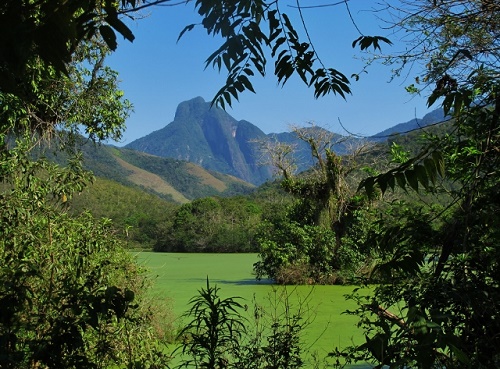- Início
- Escola Desempenho
- About the region
Cachoeiras de Macacu
About the region
Cachoeiras de Macacu is 90 km (1 ½ hours) from Rio de Janeiro in the foothills of the Serra do Mar.
Its landscape of mountains and hills, rural areas, forests, interspersed with rivers and the presence of many waterfalls is enchanting. Due to its large protected area and its importance as a water source, the municipality has one of the highest Final Environmental Conservation Index (IFCA) scores in the state of Rio de Janeiro.

The region is still home to important fragments of the Mata Atlântica. The highest levels of biodiversity in the entire state of Rio de Janeiro have been found in this stretch of the Serra do Mar. Large mammals such as the muriqui and the jaguar still survive here. Cachoeiras de Macacu is also very attractive to birdwatchers. The Wikiaves website lists 425 species of birds.
The highest point is Pico de Caledonia (2257 m) on the border with Nova Friburgo. From the top you have one of the most beautiful views of the mountains and other nearby towns, and you can even see Guanabara Bay and part of the city of Rio de Janeiro.

Almost half of the municipality’s area is protected. The main area is the Três Picos State Park (PETP), about two thirds of which is in Cachoeiras de Macacu. The rest is divided between the municipalities of Nova Friburgo, Teresópolis, Silva Jardim and Guapimirim. It is the largest environmental conservation unit in the state of Rio de Janeiro’s integral protection group. Another key area is the Guapi Açu RPPN (REGUA), which is a partner of iHOCA and the Desempenho Riding School.

The PETP forms a forest continuum with the Serra dos Órgãos National Park and the Paraíso State Ecological Station, which increases its importance as a refuge for countless species of Rio de Janeiro’s fauna and flora, especially mammals and birds. Together with other conservation units, this area forms the Central Fluminense Mosaic.

The region was already colonized in the 16th century and has always had a rural vocation. In the second part of the 19th century, the Leopoldina Railroad (Cantagalo branch) made Cachoeiras de Macacu or Raiz da Serra de Novo Friburgo a stopping point on the line from Baia de Guanabara to Cantagalo. The railroad was decommissioned in 1965. Today, without the tracks, the path that was used by the train is used by trekking and ecotourism enthusiasts and is an important ecological and cultural route, as it still preserves, in a reasonable state of conservation, old iron bridges and stations, the latter already covered by the forest.

Modalities,
Classes and Clinics
Contact
- Estrada Antônio José, km 5, Faraó, Cachoeiras de Macacu - RJ
- +55 (21) 98156-0212 (Tim) +55 (21) 99765-8576
- escola@desempenho.esp.br
Escola Desempenho de Equitação. All rights reserved.
Developed by Infinity Marketing
Desenvolvido por Trinta&Seis Consultoria Digital. Faça seu site conosco hoje mesmo.
